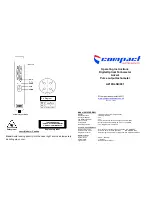
Heat meter calculator QALCOMET HEAT 1
PEQMH1V01
17
Parameters measured in each measurement channel together with archive parameters are stored in
memory and can be displayed on LCD, printed, transmitted through optical interface or through bi-
directional galvanic ally-insolated M-Bus, CL or RS-232 interface.
If current output module is used, 1-st current output parameter will correspond to 1-st pulse output
parameter (respectively 2-nd current output parameter will correspond to 2-st pulse output parameter). In
this case output frequency mode should be activated. Minimum value of the selected range of a current
will correspond to zero (0) value of the output parameter, and maximum value of the selected range of
current will correspond to the maximum value of the chosen parameter: flow rate
- q
max
,
temperature
-
160 °C, pressure
- p
max
, or thermal power - q
max
* 100 [kW], where the q
max
-maximum
flow rate
[m3/h] for this system.
User may set current limits (0-20mA or 4-20mA) by using appropriate jumpers.
5. MARKING AND SEALING
5.1.Marking:
There are following information on the front panel of calculator -
manufacturer’s trade mark , type
of calculator, serial number, year of manufacture, EC-type examination certificate number, limits of the
temperature, limits of the temperature differences, environmental class by LST EN1434-1,
electromagnetic and mechanical environmental class, enclosure protection class, type of temperature
sensors, conditional designation of measuring scheme for1st and 2nd heating system, flow sensor placing
(in forward or return pipe), flow inputs pulse values, maximum flow rate, power supply.
Numbers of terminal pins are marked close to the terminal
5.2.Sealing:
The following calculator sealing is provided:
M
anufacturer’s warranty seal
- adhesive sticker on the fixing bolt of electronic module under
protecting cover (Fig. 8.2, pos. 1)
After verification m
anufacturer’s security
seal - adhesive sticker on the bolt of cover protecting
electronic module (Fig. 8.2, pos.2)
Installation seals
–
hanged seals on the fixers of junction of the top and bottom part of the housing
of calculator (see Appendix D).
5.3. Flow, temperature and pressure sensors are marked and sealed according to requirements
provided in relevant technical documentation.
6. SAFETY REQUIREMENTS
The calculator is made and inspected in compliance with EN61010-1.
There are no life dangerous factors, when calculation unit is powered from 3,6 V lithium battery.
If calculation unit is powered from mains power supply, it contains dangerous ~230 V electrical current.
It is necessary to follow general safety requirements during installation and maintenance process.
The electrical connections must be made in compliance with the relevant standard while
observing local safety regulations. Only qualified technical personnel may install and maintain heat
meters (certificates for electrical installation work with equipment up to 1000 V are required). Personnel
must be familiar with appropriate technical documentation and general safety instructions. To ensure safe
operation, the user must observe the notes and warnings contained in this instruction.
Protective grounding is not required, because housing is made from plastics, and conductive parts are
not exposed to the surface. Device comply with the II safety class.
To prote
ct power circuits from current overrun, 1A fuse, marked “F1”, is mounted on the bottom
side of power supply module. Remove power supply module to replace the fuse.
If relay output current exceeds 2 A, it may damage output circuits. It is recommended to use
additional protection circuits to protect relay outputs from damage.
Operation safety requires reliable isolation of electrical circuits, stable mounting of calculating
unit and proper grounding of all system components.
Safety requirements for flow, temperature and pressure sensors are provided in appropriate
technical documentation.
Warning! Switch off mains power supply before changing, repairing, connecting or
disconnecting system parts! Power switch has to be installed close to the calculator.
Summary of Contents for HEAT 1
Page 6: ...Heat meter calculator QALCOMET HEAT 1 PEQMH1V01 6...
Page 39: ...Heat meter calculator QALCOMET HEAT 1 PEQMH1V01 39...
Page 40: ...Heat meter calculator QALCOMET HEAT 1 PEQMH1V01 40...
Page 41: ...Heat meter calculator QALCOMET HEAT 1 PEQMH1V01 41...
Page 42: ...Heat meter calculator QALCOMET HEAT 1 PEQMH1V01 42...
Page 52: ...Heat meter calculator QALCOMET HEAT 1 PEQMH1V01 52...
















































